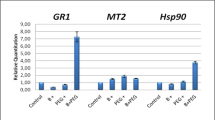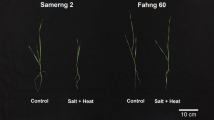Abstract
In this study, we examined physiological, biochemical, and transcriptomic responses to toxic boron (B) treatment in leaves and roots of two wheat cultivars in order to gain better insight into B response or tolerance mechanisms. Delayed development and reduced vigor caused by high B were not observed in leaves and roots of both cultivars. Length, wet weight, and dry weight were not markedly changed under B toxicity. In leaves, when compared to control, 995 and 892 genes were significantly expressed at least twofold under B toxicity in Atay and Bolal, respectively. In roots, expressions of 1248 and 957 genes were responsive to B toxicity in Atay and Bolal, respectively. In leaf and root tissues, B toxicity induced more genes related to protein degradation in Atay than those in Bolal. These differences in transcriptome were attributed to higher B accumulation in the sensitive cultivar which required high level of metabolic adjustment. B toxicity stress did not cause any significant change in photosynthetic activity and contents of proline and glycine betaine in both cultivars. Coordinately, we did not find any differentially expressed genes required for proline and glycine betaine metabolisms. Genes related to hormone signaling, kinases, transcription factors such as WRKY and MYB, and key enzymes in reactive oxygen species (ROS) scavenging mechanisms were differentially affected by B toxicity in both cultivars. Among commonly regulated genes in Atay and Bolal, glutathione S-transferase (GST) and NIP4;1 (nodulin-26-like intrinsic proteins) genes stand out as prominent actors in B stress response.


Similar content being viewed by others
References
Ashraf M, Foolad MR (2007) Roles of glycine betaine and proline in improving plant abiotic stress resistance. Environ Exp Bot 59:206–216
Atik AE, Bozdag GO, Akinci E, Kaya A, Koc A, Yalcin T, Karakaya HÇ (2011) Proteomic changes during boron tolerance in barley (Hordeum vulgare) and the role of vacuolar proton-translocating ATPase subunit E. Turk J Bot 35:379–388
Bates LS, Waldren RP, Teare ID (1973) Rapid determination of free proline for water–stress studies. Plant Soil 39:205–207
Benjamini Y, Hochberg Y (1995) Controlling the false discovery rate: a practical and powerful approach to multiple testing. J R Stat Soc B Met 57:289–300
Binzel ML (1995) NaCl induced accumulation of tonoplast and plasma membrane H+-ATPase message in tomato. Physiol Plant 94:722–728
Bray EA (2004) Genes commonly regulated by water-deficit stress in Arabidopsis thaliana. J Exp Bot 55:2331–2341
Brown PH, Bellaloui N, Wimmer MA, Bassil ES, Ruiz J, Hu H et al (2002) Boron in plant biology. Plant Biol 4:205–223
Cervilla LM, Blasco B, Ríos JJ, Romero L, Ruiz JM (2007) Oxidative stress and antioxidants in tomato (Solanum lycopersicum) plants subjected to boron toxicity. Ann Bot 100:747–756
Chandran D, Sharopova N, Ivashuta S, Gantt JS, VandenBosch KA, Samac DA (2008) Transcriptome profiling identified novel genes associated with aluminum toxicity, resistance and tolerance in Medicago truncatula. Planta 228:151–166
Chen L, Song Y, Li S, Zhang L, Zou C, Yu D (2012) The role of WRKY transcription factors in plant abiotic stresses. Biochim Biophys Acta 1819:120–128
Chen M, Mishra S, Heckathorn SA, Frantz JM, Krause C (2014) Proteomic analysis of Arabidopsis thaliana leaves in response to acute boron deficiency and toxicity reveals effects on photosynthesis, carbohydrate metabolism, and protein synthesis. J Plant Physiol 171:235–242
Chomczynski P, Sacchi N (1987) Single-step method of RNA isolation by acid guanidinium thiocyanate-phenol-chloroform extraction. Anal Biochem 162:156–159
Degenkolbe T, Do PT, Zuther E, Repsilber D, Walther D, Hincha DK et al (2009) Expression profiling of rice cultivars differing in their tolerance to long-term drought stress. Plant Mol Biol 69:133–153
Delauney AJ, Verma DPS (1993) Proline biosynthesis and osmo-regulation in plants. Plant J 4:215–223
Devoto A, Muskett PR, Shirasu K (2003) Role of ubiquitination in the regulation of plant defense against pathogens. Curr Opin Plant Biol 6:307–311
Ergen NZ, Thimmapuram J, Bohnert HJ, Budak H (2009) Transcriptome pathways unique to dehydration tolerant relatives of modern wheat. Funct Integr Genomics 9(3):377–396
Grbic V, Bleecker AB (1995) Ethylene regulates the timing of leaf senescence in Arabidopsis. Plant J 8:595–602
Gregersen PL, Holm PB (2007) Transcriptome analysis of senescence in the flag leaf of wheat (Triticum aestivum L.). Plant Biotechnol J 5:192–206
Grieve CM, Grattan SR (1983) Rapid assay for determination of water soluble quaternary ammonium compounds. Plant Soil 70:303–307
Hayes JE, Reid RJ (2004) Boron tolerance in barley is mediated by efflux of B from the roots. Plant Physiol 136:3376–3382
Hellmann H, Estelle M (2002) Plant development: regulation by protein degradation. Science 297:793–797
Hoagland DR, Arnon DI (1950) The water-culture method for growing plants without soil. Calif Agric Exp Station Circ 347:1–32
Huang J, Yang X, Wang MM, Tang HJ, Ding LY, Shen Y, Zhang HS (2007) A novel rice C2H2-type zinc finger protein lacking DLN-box/EAR-motif plays a role in salt tolerance. Biochim Biophys Acta 1769:220–227
Janicka-Russak M, Kabala K, Burzynski M, Klobus G (2008) Response of plasma memberane H+-ATPase to heavy metal stress in Cucumis sativus roots. J Exp Bot 59:3721–3728
Kasajima I, Fujiwara T (2007) Identification of novel Arabidopsis thaliana genes which are induced by high levels of boron. Plant Biotechnol 24:355–360
Kiełbowicz-Matuk A (2012) Involvement of plant C2H2-type zinc finger transcription factors in stress responses. Plant Sci 185–186:78–85
Kumari M, Taylor GJ, Deyholos MK (2008) Transcriptomic responses to aluminum stress in roots of Arabidopsis thaliana. Mol Genet Genomics 279:339–357
Landi M, Deglinnocenti E, Pardossi A et al (2012) Antioxidant and photosynthetic responses in plants under boron toxicity: a review. Am J Agric Biol Sci 7:255–270
Lichtenthaler HK (1987) Chlorophylls and carotenoids: pigments of photosynthetic membranes. Methods Enzymol 148:350–382
Lim PO, Kim HJ, Gil Nam H (2007) Leaf senescence. Annu Rev Plant Biol 58:115–136
Martinez-Cuenca MR, Martinez-Alcantara B, Quiñones A, Ruiz M, Iglesias DJ, Primo-Millo E, Forner-Giner MA M (2015) Physiological and molecular responses to excess boron in Citrus macrophylla W. PLoS One 10:e0134372
Miwa K, Takano J, Omori H, Seki M, Shinozaki K, Fujiwara T (2007) Plants tolerant of high boron levels. Science 318:1417
Nable RO (1988) Resistance to boron toxicity amongst several barley and wheat cultivars: a preliminary examination of the resistance mechanism. Plant Soil 112:45–57
Nable RO, Cartwright B, Lance RC (1990) Genotypic differences in boron accumulation in barley: relative susceptibilities to boron deficiency and toxicity. In: Bassam NEl et al. (Ed.) Genetic aspects of plant mineral nutrition, Kluwer Academic Publishers, pp 243–251
Nable RO, Banuelos GS, Paull JG (1997) Boron toxicity. Plant Soil 193:181–198
Nanjo T, Kobayashi M, Yoshiba Y, Kakubari Y, Yamaguchi-Shinozaki K, Shinozaki K (1999) Antisense suppression of proline degradation improves tolerance to freezing and salinity in Arabidopsis thaliana. FEBS Lett 461:205–210
Oertli JJ, Roth JA (1969) Boron nutrition of sugar beet, cotton, and soybean. Agron J 61:191–195
Oxborough K (2004) Imaging of chlorophyll a fluorescence: theoretical and practical aspects of an emerging technique for the monitoring of photosynthetic performance. J Exp Bot 55:1195–1205
Öz MT, Yilmaz R, Eyidogan F, Graaff L, Yucel M, Oktem HA (2009) Microarray analysis of late response to boron toxicity in barley (Hordeum vulgare L.) leaves. Turk J Agric For 33:191–202
Öz MT, Turan Ö, Kayıhan C, Eyidoğan F, Ekmekçi Y, Yücel M, Öktem HA (2014) Evaluation of photosynthetic performance of wheat cultivars exposed to boron toxicity by the JIP fluorescence test. Photosynthetica 52:555–563
Ozturk ZN, Talame V, Deyhoyos M, Michalowski CB, Galbraith DW, Gozukirmizi N, Tuberosa R, Bohnert HJ (2002) Monitoring large-scale changes in transcript abundance in drought- and salt-stressed barley. Plant Mol Biol 48:551–573
Padmalatha KV, Dhandapani G, Kanakachari M, Kumar S, Dass A, Patil DP et al (2012) Genome-wide transcriptomic analysis of cotton under drought stress reveal significant down-regulation of genes and pathways involved in fibre elongation and up-regulation of defense responsive genes. Plant Mol Biol 78:223–246
Padmanabhan P, Babaoglu M, Terry N (2012) A comparative transcriptomic analysis of the extremely boron tolerant plant Puccinellia distans with the moderately boron tolerant Gypsophila arrostil. Plant Cell Rep 31:1407–1413
Passardi F, Penel C, Dunand C (2004) Performing the paradoxical: how plant peroxidases modify the cell wall. Trends Plant Sci 9:534–540
Patterson J, Ford K, Cassin A, Natera S, Bacic A (2007) Increased abundance of proteins involved in phytosiderophore production in boron-tolerant barley. Plant Physiol 144:1612–1631
Paull JG, Cartwright B, Rathjen A (1988) Responses of wheat and barley genotypes to toxic concentrations of soil boron. Euphytica 39:137–144
Reid R (2007) Identification of boron transporter genes likely to be responsible for tolerance to boron toxicity in wheat and barley. Plant Cell Physiol 48:1673–1678
Reid RJ, Hayes JE, Post A, Stangoulis JCR, Graham RD (2004) A critical analysis of the causes of boron toxicity in plants. Plant Cell Environ 25:1405–1414
Roessner U, Patterson JH, Forbes MG, Fincher GB, Langridge P, Bacic A (2006) An investigation of boron toxicity in barley using metabolomics. Plant Physiol 142:1087–1101
Sakamoto T, Inui YT, Uraguchi S, Yoshizumi T, Matsunaga S, Mastui M, Umeda M, Fukui K, Fujiwara T (2011) Condensin II alleviates DNA damage and is essential for tolerance of boron overload stress in Arabidopsis. Plant Cell 23:3533–3546
Shorrocks V (1997) The occurrence and correction of boron deficiency. Plant Soil 193:121–148
Sugano S, Kaminaka H, Rybka Z, Catala R, Salinas J, Matsui K, Ohme-Takagi M, Takatsuji H (2003) Stress-responsive zinc finger gene ZPT2-3 plays a role in drought tolerance in petunia. Plant J 36:830–841
Suzuki G, Yanagawa Y, Kwok SF et al (2002) Arabidopsis COP10 is a ubiquitin-conjugating enzyme variant that acts together with COP1 and the COP9 signalosome in repressing photomorphogenesis. Genes Dev 16:554–559
Takano J, Wada M, Ludewig U, Schaaf G, von Wiren N, Fujiwara T (2006) The Arabidopsis major intrinsic protein NIP5;1 is essential for efficient boron uptake and plant development under boron limitation. Plant Cell 18:1498–1509
Theodolou FL (2000) Plant ABC transporters. Biochim Biophys Acta 1465:79–103
Thimm O, Blaesing O, Gibon Y, Nagel A, Meyer S, Krüger P, Selbig J, Müller LA, Rhee SY, Stitt M (2004) MAPMAN: a user-driven tool to display genomics data sets onto diagrams of metabolic pathways and other biological processes. Plant J 37:914–939
Thines B, Katsir L, Melotto M, Niu Y, Mandaokar A, Liu G, Nomura K, He SY, Howe GH, Browse J (2007) JAZ repressor proteins are targets of the SCF(COI1) complex during jasmonate signaling. Nature 448:661–665
Tombuloglu G, Tombuloglu H, Sakcali MS, Unver T (2015) High-throughput transcriptome analysis of barley (Hordeum vulgare) exposed to excessive boron. Gene 557:71–81
Torun A, Yazici A, Erdem H, Cakmak I (2006) Genotypic variation in tolerance to boron toxicity in 70 durum wheat genotypes. Turk J Agric For 30:49–58
Walia H, Wilson C, Condamine P et al (2005) Comparative transcriptional profiling of two contrasting rice genotypes under salinity stress during the vegetative growth stage. Plant Physiol 139:822–835
Walia H, Wilson C, Zeng L et al (2007) Genome-wide transcriptional analysis of salinity stressed japonica and indica rice genotypes during panicle initiation stage. Plant Mol Biol 63:609–623
Warington K (1923) The effect of boric acid and borax on the broad bean and certain other plants. Ann Bot 37:629–672
Yan X, Wu P, Ling H, Xu G, Xu F, Zhang Q (2006) Plant nutriomics in China: an overview. Ann Bot 98:473–482
Yoshiba Y, Kiyosue T, Nakashima K, Yamaguchi-Shinojaki K, Shinojaki K (1997) Regulations of levels of proline as an osmolyte in plants under water stress. Plant Cell Physiol 38:1095–1102
Zhou GA, Chang RZ, Qiu LJ (2010) Overexpression of soybean ubiquitin-conjugating enzyme gene GmUBC2 confers enhanced drought and salt tolerance through modulating abiotic stress-responsive gene expression in Arabidopsis. Plant Mol Biol 72:357–367
Acknowledgments
We would like to thank Middle East Technical University Central Lab. for contributing efforts to microarray and bioanalyzer experiments. This work was supported by the National Boron Research Institute (BOREN-2009-Ç0217) and Faculty Development Program of Middle East Technical University (BAP-08-11-DPT2002 K120510).
Author information
Authors and Affiliations
Corresponding author
Rights and permissions
About this article
Cite this article
Kayıhan, C., Öz, M.T., Eyidoğan, F. et al. Physiological, Biochemical, and Transcriptomic Responses to Boron Toxicity in Leaf and Root Tissues of Contrasting Wheat Cultivars. Plant Mol Biol Rep 35, 97–109 (2017). https://doi.org/10.1007/s11105-016-1008-9
Published:
Issue Date:
DOI: https://doi.org/10.1007/s11105-016-1008-9




